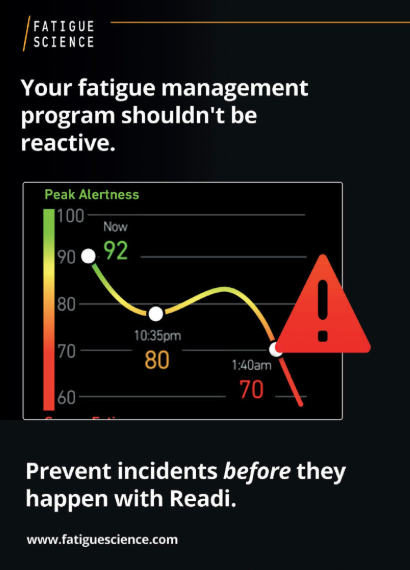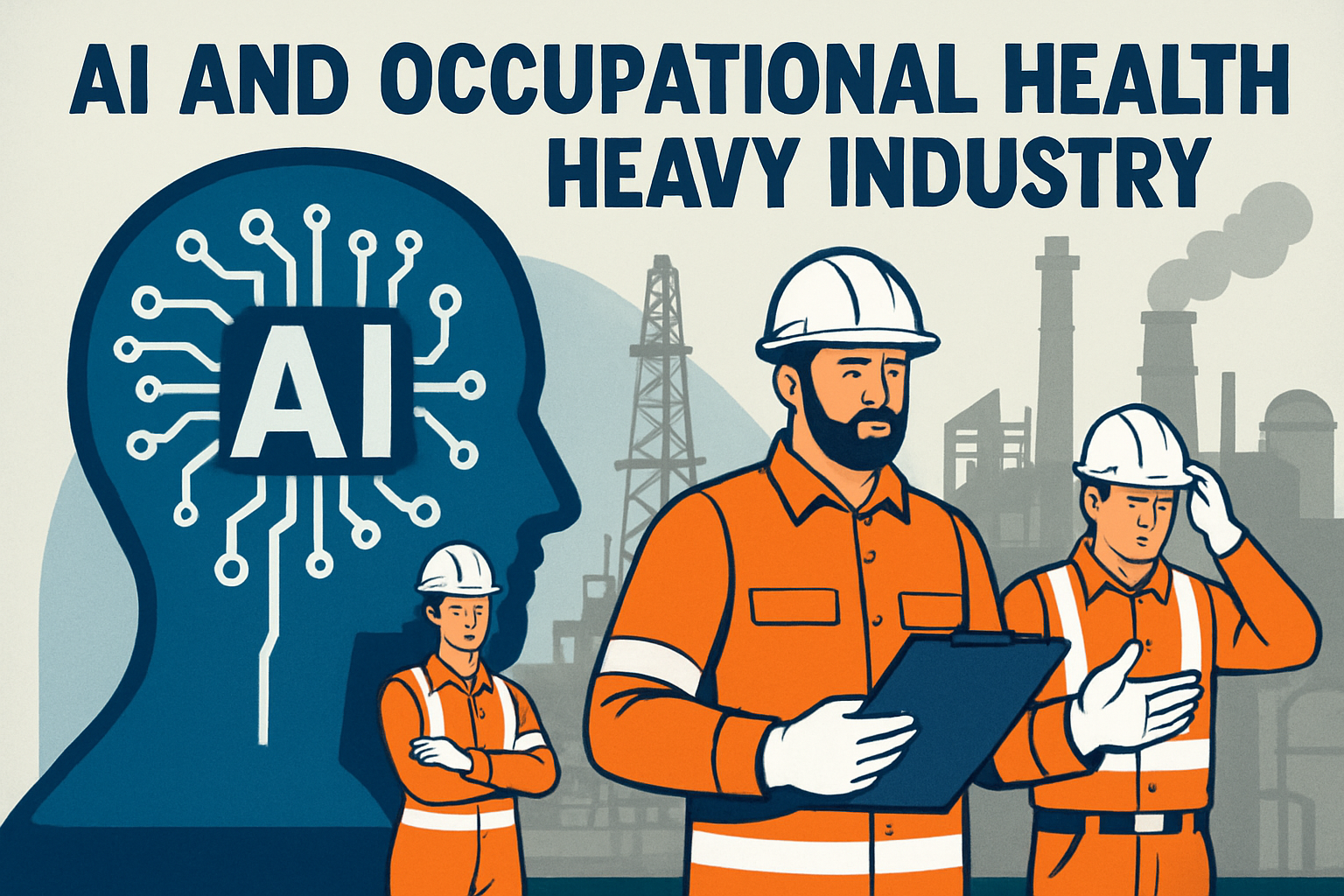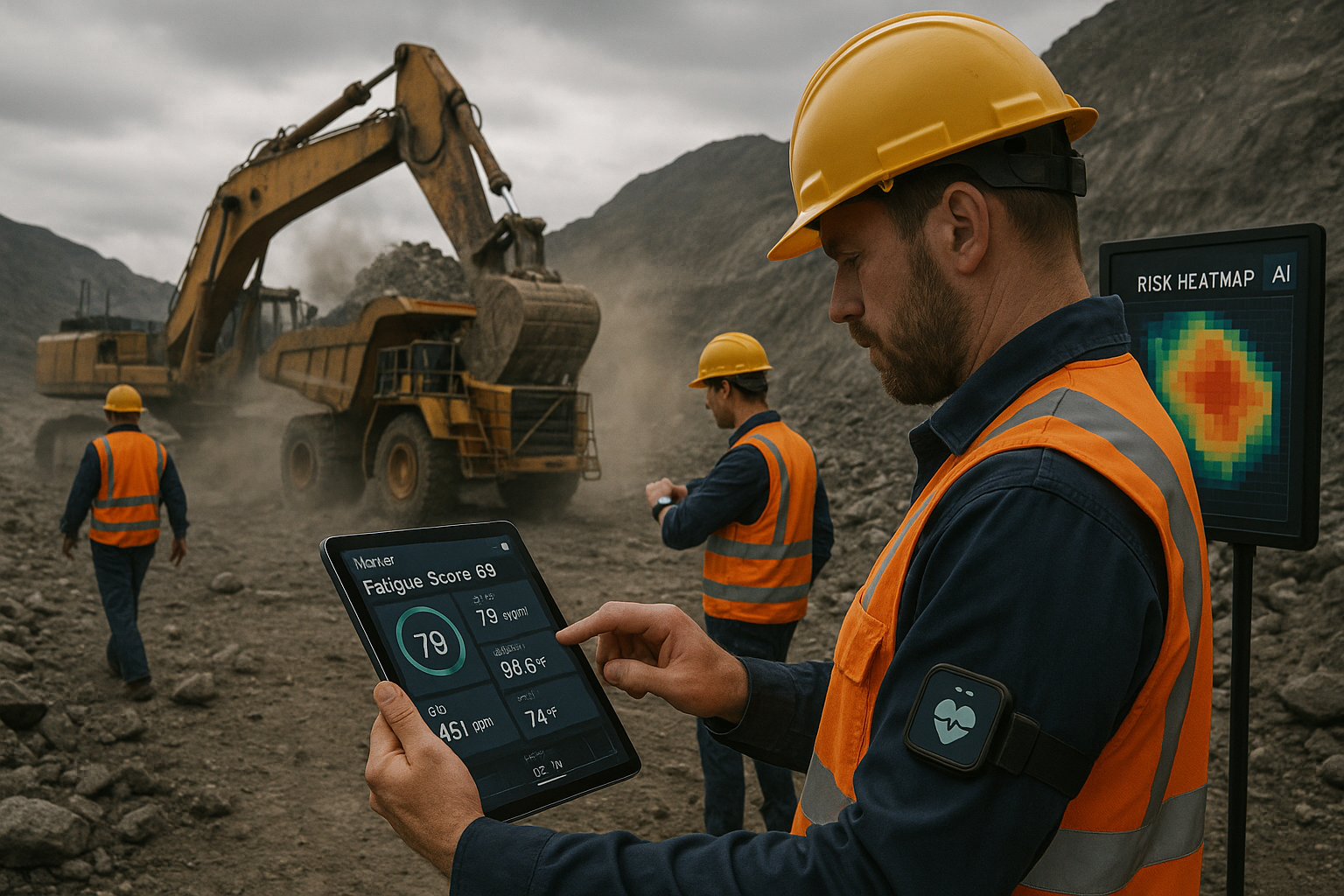Workplace safety has evolved from clipboards and quarterly audits to sophisticated systems that monitor, predict, and prevent incidents around the clock. Today's safety professionals manage complex operations where a single oversight can mean the difference between a near-miss and a catastrophic event—particularly in industries where workers operate heavy machinery, work extended shifts, or navigate hazardous environments.
Artificial intelligence now serves as a critical ally in this mission, transforming reactive safety programs into proactive shields against workplace incidents. These AI-powered systems analyze patterns invisible to the human eye: subtle changes in worker movements that signal fatigue, equipment vibrations that precede failure, or environmental conditions that create perfect storms for accidents.
The shift represents more than technological advancement; it marks a fundamental change in how organizations protect their workforce. Where safety teams once relied on historical data and periodic observations, they now access continuous intelligence streams that identify risks as they emerge, not after someone gets hurt.
Summary
- AI transforms workplace safety from reactive to proactive, enabling continuous risk identification and real-time intervention.
- Advanced analytics and machine learning detect subtle risk patterns, predicting incidents before they escalate.
- Integration with wearables, sensors, and operational systems enhances data-driven decision-making and supports compliance.
- Automated monitoring and reporting streamline processes, improving operational efficiency while reducing administrative burden.
- A strategic approach to AI adoption builds a culture of safety, optimizing ROI and fostering measurable safety improvements across industries.
What Is AI in Workplace Safety?
Definition and Core Components
AI workplace safety encompasses the deployment of artificial intelligence technologies to predict, prevent, and manage safety risks through continuous data analysis and automated monitoring. These systems fundamentally differ from traditional safety approaches that depend on scheduled inspections and reactive incident management—instead, they provide uninterrupted assessment of workplace conditions through sophisticated algorithms that process information from multiple sources simultaneously.
The architecture of these AI safety management tools combines several key technologies working in concert. Machine learning algorithms form the analytical backbone, processing vast datasets from cameras, environmental sensors, wearable devices, and historical incident reports. Computer vision systems—powered by convolutional neural networks—extract critical safety information from video feeds, identifying everything from PPE compliance to unsafe behaviors like workers entering restricted zones. Meanwhile, predictive analytics engines synthesize this information to create comprehensive safety profiles that help organizations understand not just what happened, but what might happen next.
How AI Transforms Traditional Safety Practices
Traditional safety management operates on a foundation of periodic audits, manual inspections, and standardized checklists—methods that served industry well for decades but leave dangerous gaps between assessments. Consider a manufacturing facility where safety walks occur weekly: hazards emerging on Tuesday might persist undetected until the following Monday's inspection. AI-driven safety solutions eliminate these blind spots through continuous monitoring that operates 24/7, detecting unsafe behaviors and conditions the moment they occur.
The transformation extends beyond simple surveillance. Machine learning algorithms excel at identifying subtle patterns that human observers routinely miss—patterns like the slight change in gait that indicates worker fatigue, the barely perceptible equipment vibration that precedes catastrophic failure, or the combination of environmental factors that historically correlate with increased incident rates. These systems learn from every data point, becoming more sophisticated with each passing day.
Real-time safety insights fundamentally change the intervention timeline. Rather than discovering problems during scheduled reviews or investigating after incidents occur, safety teams receive immediate alerts when risks emerge. A worker approaching an energized electrical panel without proper lockout/tagout procedures triggers an instant notification. Equipment operating outside normal parameters generates warnings before failure occurs. This shift from reactive to predictive safety management represents perhaps the most significant advancement in workplace safety since the introduction of personal protective equipment.
Benefits of Using AI for Safety Management
Enhanced Risk Prediction and Prevention
AI's capacity for analyzing extensive workplace data transforms safety management from a reactive to a strategically proactive approach. By leveraging comprehensive datasets that encompass historical incidents, real-time environmental inputs, and worker behavior analytics, AI systems can anticipate potential safety issues before they manifest. This foresight empowers organizations to implement preemptive measures, effectively minimizing risk.
Advanced predictive analytics enable precise identification of high-risk periods and critical locations, facilitating more efficient resource allocation.
For example, AI can pinpoint when and where additional safety measures are necessary, optimizing the deployment of personnel and resources. Machine learning algorithms continuously evolve, adjusting their predictive capabilities to new information, thereby improving their reliability.
Systems like those used in fatigue management provide timely alerts about potential hazards, ensuring that emerging risks are addressed promptly, safeguarding the workforce from escalating threats.
Improved Compliance and Reporting
AI compliance solutions streamline the adherence to safety standards through automation, ensuring comprehensive tracking and documentation of safety protocols. This technological advancement reduces administrative workload, allowing safety teams to focus on more strategic objectives.
By automating data collection and reporting, AI enhances the accuracy and reliability of safety audits, providing a more truthful representation of workplace conditions.
Continuous compliance monitoring facilitated by AI surpasses traditional audit methods, offering real-time oversight that quickly identifies and corrects deviations from safety norms. When non-compliance is detected, AI systems can automatically initiate corrective actions, thereby maintaining regulatory adherence and reducing the risk of penalties. This proactive approach to compliance ensures that safety standards are consistently met, fostering a culture of continuous improvement.
Operational Efficiency Gains
The implementation of AI in safety management significantly enhances operational efficiency by automating routine monitoring tasks, thereby liberating safety professionals to engage in higher-level strategic planning. This shift not only maximizes the impact of safety initiatives but also allows teams to adapt dynamically to changing safety environments.
AI systems' ability to oversee multiple sites concurrently extends the reach of safety programs without necessitating additional staffing. By integrating seamlessly with existing safety management frameworks, AI optimizes workflow efficiency, eliminating redundant tasks and streamlining processes.
The financial benefits—stemming from fewer incidents, lower insurance costs, and increased productivity—often outweigh the initial investment in AI solutions, making them an attractive proposition for modern safety management.
Key AI Technologies for Workplace Safety
Computer Vision and Video Analytics
At the forefront of workplace safety innovation, computer vision and video analytics redefine how organizations enforce safety measures. These advanced systems utilize AI algorithms integrated with camera networks to deliver live surveillance over operational areas. By identifying potential hazards, verifying PPE compliance, and recognizing risky behaviors, they provide a robust and continuous safety framework across industries.
Video analytics offer an enhanced layer of scrutiny by detecting specific safety breaches, such as unauthorized entries into secure zones or deviations from established procedures. This capability ensures rigorous safety adherence without necessitating constant human supervision. Cutting-edge systems monitor numerous safety metrics across expansive facilities, maintaining vigilance autonomously. The integration of these technologies with existing CCTV setups ensures a seamless, cost-effective deployment that minimizes operational disruptions—making them a prudent choice for businesses aiming to elevate their safety protocols.
Machine Learning in Occupational Safety
At the heart of contemporary safety solutions, advanced analytical models offer profound insights by examining extensive safety data to uncover risk factors contributing to workplace incidents. These models learn iteratively from incidents and near-misses, continuously enhancing their predictive accuracy—adapting to new patterns and variables. By identifying these risk factors, organizations can implement proactive measures, mitigating hazards before they emerge.
Integral to these solutions is natural language processing, which meticulously examines incident narratives and safety records to distill valuable insights and detect emerging trends. This functionality allows safety managers to address underlying issues promptly. These adaptive systems ensure ongoing refinement, evolving with shifting workplace dynamics and procedures, thereby maintaining the effectiveness of safety protocols in diverse, ever-changing environments.
Predictive Analytics Platforms
Predictive analytics platforms leverage artificial intelligence to anticipate safety risks, focusing on areas like fatigue management. These sophisticated systems consolidate data from various sources, such as work schedules, environmental sensors, and biometric readings, to evaluate potential fatigue-related risks. By employing complex algorithms, these platforms prioritize safety measures based on both the probability and potential impact of incidents, facilitating strategic resource allocation.
The intuitive dashboard interfaces of these platforms convert complex datasets into actionable insights, enabling safety teams to make informed decisions rapidly. Instead of navigating through raw data, teams receive clear, prioritized information that supports immediate action. This capability not only streamlines decision-making but also promotes a proactive safety management approach, fostering a safer, more efficient workplace environment.
Implementation Strategies for AI Safety Solutions
Assessing Your Organization's Readiness
Before embarking on AI safety initiatives, it's essential to evaluate your organization's current capabilities and needs. Start by analyzing existing safety management processes to identify areas where AI can introduce substantial enhancements. This involves a detailed review of current practices to uncover inefficiencies or gaps that AI technologies might address. Equally important is assessing your technological framework to ensure it supports AI requirements, as comprehensive data inputs are vital for effective AI deployment.
Evaluate the technical proficiency within your team, as successful AI integration relies heavily on the ability to adapt and utilize new tools. Tailored training programs may be necessary to develop any lacking skills, ensuring your workforce can fully leverage AI capabilities. Identify key safety challenges specific to your operations—AI is particularly effective in areas like predictive risk management and real-time monitoring, making it crucial to align AI solutions with these pressing needs.
Choosing the Right AI Safety Tools
When selecting AI tools, adopt a strategic approach tailored to your industry's unique demands and regulatory landscape. Focus on solutions that seamlessly integrate with existing safety protocols to enhance current operations without causing disruptions. For heavy industries facing significant safety challenges, consider systems that incorporate predictive analytics to ensure comprehensive risk coverage.
Prioritize tools with a proven performance history in comparable environments to mitigate implementation risks and expedite the benefits realization process. Scalability is crucial—invest in AI solutions that can expand alongside your organization, adapting to dynamic safety requirements and increasing operational scope. This forward-thinking approach ensures long-term viability and adaptability, positioning your organization to meet future challenges effectively.
Integration Best Practices
Successful integration of AI safety solutions requires strategic execution, beginning with pilot programs targeting high-risk areas. These focused initiatives yield valuable insights into system performance and user interaction, allowing for refinement before broader rollout. Pilot programs also build internal support by demonstrating tangible value—success stories from these initial implementations can drive momentum for wider adoption.
Ensure seamless integration with existing safety management systems and workflows to minimize disruption and maintain continuity. Develop clear procedures for responding to AI-generated alerts, outlining steps for validation and action to enhance overall safety response strategy. Establishing robust mechanisms for ongoing feedback and evaluation allows for continuous improvement, as user experiences and system performance data inform ongoing optimization efforts.
Overcoming Common Challenges
Integrating AI into workplace safety protocols involves navigating unique challenges that require strategic planning and thoughtful execution.
Organizations must address privacy issues, build workforce trust, and ensure system reliability to fully leverage the benefits of AI-enhanced safety solutions. By tackling these challenges head-on, companies can create environments where AI serves as an ally in maintaining safety standards without undermining worker confidence or operational stability.
Addressing Privacy and Ethical Concerns
Ensuring transparency in data handling is crucial when deploying AI in the workplace. Establishing clear, accessible policies about how data is collected and used reassures workers and fosters a culture of trust. By focusing on general workplace conditions and behaviors rather than individual performance metrics, AI systems can alleviate concerns about surveillance and misuse—prioritizing worker safety over monitoring.
The AI systems should augment human oversight, particularly in critical decision-making scenarios. This approach preserves the human element in safety management, ensuring that expert judgment and intuition remain integral components of the safety strategy. Adopting robust data governance policies safeguards employee privacy while maintaining essential safety oversight—reinforcing the organization’s commitment to ethical practices and worker protection.
Managing Change and Building Trust
The success of AI integration hinges on the active involvement and support of your workforce. Engage employees and safety teams early in the AI adoption process to foster ownership and engagement. This involvement provides practical insights into workplace dynamics, ensuring AI solutions are tailored to meet actual needs and challenges.
Comprehensive training is key to demonstrating how AI tools complement existing safety measures rather than replace them. Training sessions should highlight the additional layer of protection AI provides, emphasizing its supportive role in maintaining a safe work environment. Sharing success stories and quantifiable improvements builds confidence in the technology, offering concrete evidence of AI’s positive impact. Open communication about concerns and AI's role in safety underscores the organization’s dedication to worker welfare and collaboration.
Ensuring Data Quality and System Reliability
The effectiveness of AI in safety management relies heavily on the integrity of data inputs and the reliability of the systems themselves. Implementing robust data collection and validation processes ensures that AI systems operate based on accurate and relevant information, which is essential for developing reliable predictive models.
To guard against potential disruptions, implementing redundancy and fail-safe mechanisms is vital. These strategies ensure continuous safety coverage, even during system outages, preserving operational integrity and worker safety. Regular audits and system updates are necessary to adapt to evolving conditions, keeping the technology effective over time. Partnering with vendors who offer ongoing support and system optimization provides additional assurance, helping organizations maximize the benefits of AI technology while navigating its complexities.
Future of AI in Workplace Safety
Emerging Technologies and Trends
The expansion of AI in workplace safety introduces transformative technologies that redefine operational protocols. Wearable devices paired with AI platforms provide continuous health and safety monitoring, offering real-time data on worker conditions and surroundings. This integration allows for immediate adjustments to enhance safety on the ground. Moreover, advancements in natural language processing streamline safety communications, enabling intuitive voice-activated reporting and guidance. This innovation ensures that vital safety information is accessible and actionable in real-time, even during critical situations.
Augmented reality (AR) is set to revolutionize on-site safety practices by projecting crucial safety data directly into workers' fields of view. This technology facilitates informed decision-making without interrupting workflow. Additionally, autonomous safety systems are on the rise, capable of executing preventative measures independently. These systems assess potential risk scenarios and implement immediate interventions, allowing human resources to prioritize strategic oversight and continuous enhancement of safety protocols.
Building a Proactive Safety Culture
AI's role extends beyond technology, fostering a culture of proactive safety management. By anticipating risks before they occur, AI establishes a foundation for preventive action, moving away from traditional reactive approaches. This shift is supported by real-time feedback, which helps workers quickly adapt their behaviors to align with safety standards, thereby reducing the likelihood of incidents and promoting a culture of vigilance.
Data-driven analysis plays a critical role in shaping evidence-based safety training and policies. These insights ensure that programs are tailored to address specific workplace challenges and are continuously updated to reflect evolving needs. By embedding continuous improvement into daily safety practices, AI empowers organizations to integrate safety as a core component of their operational strategy, aligning with broader business objectives.
Maximizing ROI from AI Safety Investments
Strategic implementation of AI in safety management delivers measurable financial benefits, enhancing return on investment (ROI) through tangible savings and increased productivity. By monitoring both leading and lagging indicators, organizations gain a comprehensive understanding of AI’s impact on safety metrics. This dual focus supports informed decision-making and targeted interventions.
AI-generated insights streamline resource allocation, optimizing safety investments to maximize impact. This precision reduces unnecessary spending and directs resources to initiatives with the highest potential for improvement. Building a strong case for expanded AI adoption relies on demonstrating clear benefits from initial deployments. As organizations witness the positive outcomes of AI in enhancing safety and operational efficiency, they are better positioned to justify further technological integration.
The journey toward safer workplaces through AI isn't just about technology—it's about creating environments where your workers return home safely every day, where operational efficiency meets human wellbeing, and where predictive insights prevent incidents before they occur. As you evaluate AI safety solutions for your organization, consider how predictive analytics, particularly in areas like fatigue management, can transform your safety outcomes from reactive responses to proactive protection.
We invite you to book a demo to explore how Fatigue Science's predictive fatigue management software can improve safety and productivity, and discover how our AI-powered approach helps organizations like yours achieve measurable improvements in both safety metrics and operational performance.
Related Posts
-
An Interview with International Mining Magazine: A New Approach to Fatigue Management in MiningMining safety has always relied on layers of protection. What’s changing now is where those layers start.
-
The Future of Occupational Health in the AI EraThe workplace safety landscape is undergoing a fundamental transformation as artificial intelligence reshapes how organizations...
-
How AI Is Shaping the Future of Occupational HealthHow AI is Shaping the Future of Occupational Health




